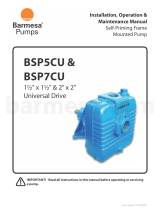
3
Recommendations, Warnings & Installation
4Receiving inspection
Upon receiving the pump, it should
be inspected for damage or
shortages. If damage has occurred,
file a claim immediately with the
company that delivered the pump. If
the manual is removed from the
packaging, do not lose or misplace.
4Storage
Any product that is stored for a
period longer than six (6) months
from the date of purchase should be
bench tested prior to installation. A
bench test consists of, checking the
impeller to assure it is free turning
and a run test to assure the motor
(and switch if provided) operate
properly.
4Controls
Manual models require a separate
approved pump control device or
panel for automatic operation. Be
sure the electrical specification of the
control selected properly match the
electrical specifications of the pump.
4Installation
Location:
The pump should be located as near
as possible to the liquid to be
pumped and in no case should the
pump be more than 25 feet above
the surface of the liquid supply. The
pump should always be as level as
possible.
Allow a minimum of 18 inches in
front of the pump case cover or
hatch cover to permit easy removal
and access to the interior of the
pump. On belt driven units, allow a
minimum of 10 inches at the shaft
end to permit easy removal of the
pedastal or rotating cartridge.
Locate the pump on a firm footing to
make sure the pump will not move
due to vibration. Flex coupled and V-
belt driven units should be
permanently grouted onto a cement
foundation. The pumps should be
level to provide favorable operating
conditions. In addition, the flexible
coupling should be realigned after
grouting in order to eliminate
excessive wear on the coupling.
It is advisable to use a suction line of
the same size as the pump port size.
All horizontal suction lines should
slope up to the pump to avoid
trapped air pockets. An adjustable
stand, pipe clamp or floor flange
must be installed to support the
weight of the suction line. Using a
smaller suction line than the pump
port size can cause internal damage
to the pump.
The bearing housing is factory filled
with 90 weight oil, for bearing
lubrication. The oil level in the
bearing housing should be
periodically checked. This is
accomplished by removing the oil
dip stick and checking oil level
shown on it. If oil is required, add
through the dip stick hole.
DO NOT OPERATE PUMP
WITHOUT LIQUID IN PUMP BODY AS
OPERATING DRY WILL RESULT IN
DAMAGE TO THE SEAL.
CAUTION
4Rotation
All pump units rotate clockwise when
looking from the driven end of the
pump. The impellers are threaded on
the shaft and it is necessary to slide
one half of the flexible coupling back
when checking rotation in order to
eliminate the possibility of
unscrewing the impeller and
damaging the pump. NOTE: Where
impellers thread on pump shaft,
never check the direction of electric
motor rotation without first
disconnecting flexible coupling.
THI S P UMP SH OULD
N O T B E O P E R AT E D W I T H O U T A
S T R A I N E R O N T H E E N D O F T H E
SUCTION LINE TO PREVENT STICKS.
STONES, RAGS AND OTHER FOREIGN
MATTER FROM BEING DRAWN INTO THE
IMPELLER. THE STRAINER SHOULD BE
CLEANED REGULARLY TO INSURE FULL
FLOW.
CAUTION
4Suction
4Discharge
Connect discharge hose or pipe to
the side outlet on the discharge tee
or to the discharge elbow.
4Driver
Read engine or motor manufacturer’s
instruction book.
4Lubrication
The only part of the pump requiring
lubrication is the bearing housing.
The impeller and shaft seal are
lubricated by the liquid being
pumped and need no other
lubrication.
4Operation
Priming:
Remove the priming plug(s) in the
top of the pump body, and fill the
pump body completely with liquid as
free of solids as possible. In freezing
weather, the pump should be primed
with warm water, if possible, to
prevent any damage that may be
caused by ice films within the pump.
Disconnect electric power or
stopping engine to shut down. It is
recommended to drain and flush
pump if pump has been operating in
freezing weather.
4Shutdown
After completion of procedures
outlined in the past sections, the
pump is then ready for operation.
Start pump by applying power to
motor or by starting engine as
outlined in the ENGINE or MOTOR
INSTRUCTION MANUAL.
4Starting












